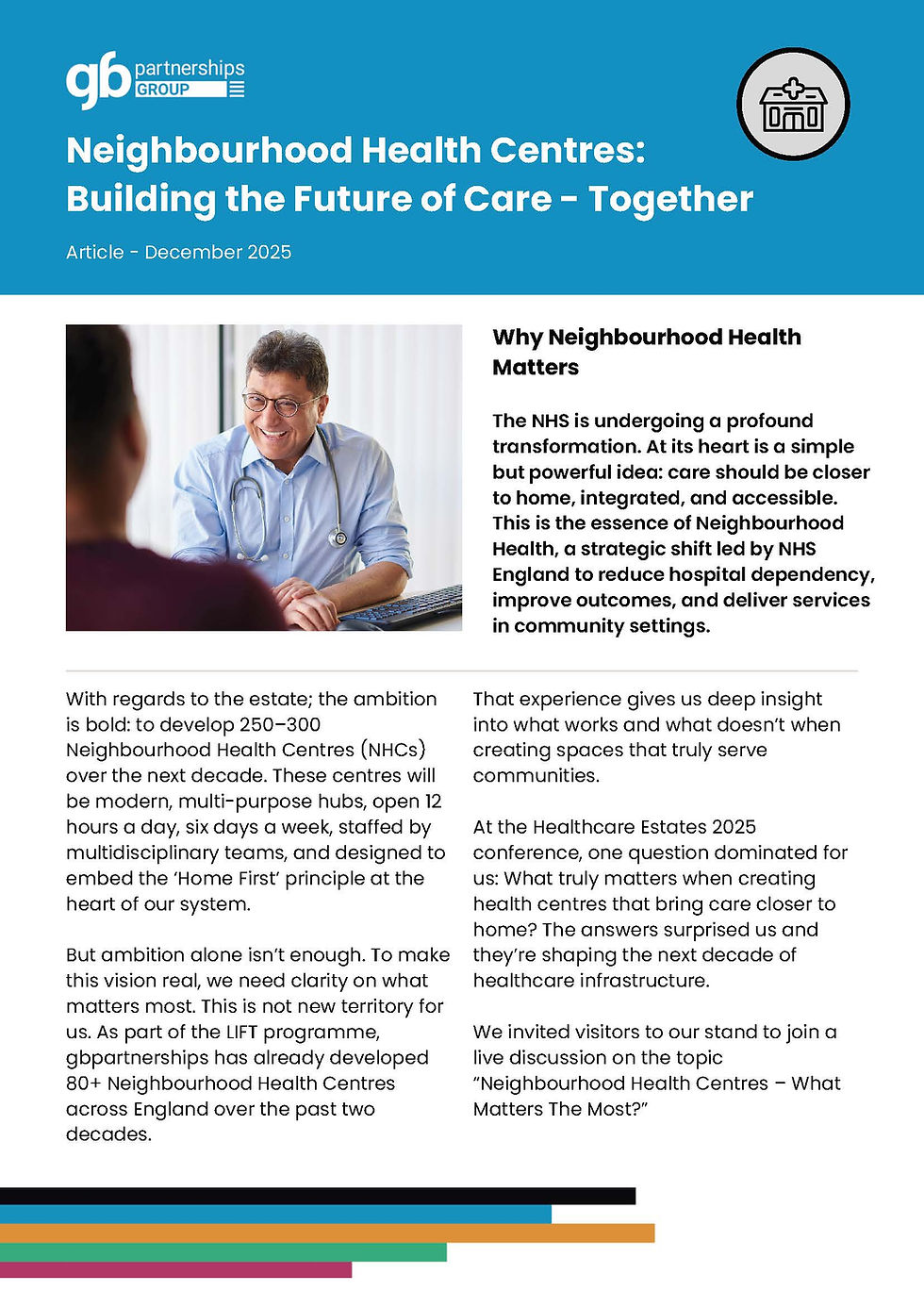Evolution, not Revolution
- gbp group

- Jan 8, 2024
- 4 min read

James Lloyd, gbp group Finance Director & Deputy CEO, explores how over 28 years of refinement of UK PPP models can be built upon to help solve our current social infrastructure challenges.
The UK has a desperate need for investment in public infrastructure. This is critical, not just to improve public services, but also to maintain our assets and keep pace with demands of an aging and growing population.
However, in a tale as old as time, the public capital available to invest in infrastructure is not enough to meet demand. When you add in issues of spiralling build costs and current economically uncertain times, not to mention a difficult political landscape, we are stuck in a bit of a rut!
With a general election looming, one thing is for certain, whichever government sits in No.10, it will need to solve the conundrum of public infrastructure investment with a limited pot of money. Therefore, it comes as no surprise that many people are talking about a resurgence of PPP/PFI as a way to solve this problem.
Resurrecting the political pariah that is PFI would be a brave move, but if the lessons of the past can be learnt, I firmly believe it would be the right one.
A focus on health. One area that greatly needs infrastructure investment is Primary Care. Primary Care is widely seen as key in reducing pressures on the acute sector, with a push towards preventative care, i.e treating people before the need to go to hospital, along with being able to provide a greater range of services to people in a more local, community setting. This is no secret and is a major reason why the likes of Wes Streeting have been exploring the Australian system which has a greater focus on care provided in local community settings.
However, the majority of the Primary Care estate is not capable of meeting these objectives, with only 1 in 5 GP’s* who believe that their current premises meets their needs. If more services are to be provided in the community, then more buildings are needed that are able to accommodate these services. Through initiatives such as the LIFT programme, we are in a much better position then we were 20 years ago. However, there is still a very long way to go.
Evolution, not revolution. Whilst in England new PFI/PPP projects have been non-existent for a good number of years, Scotland and Wales have both succeeded in launching new PPP projects, albeit in Scotland these have now also halted.
What is true for these projects, and in general when you look at PFI as a whole, is that as time has progressed, the model has been improved and lessons have been learnt.
Risk transfer between the private and public sector was optimised; profiteering was guarded against; and increasingly, the public sector had an equity stake. Therefore going forward this seems the obvious solution to our infrastructure needs.

A really good example is the LIFT - Scottish HUB - Welsh MIM evolution.
When HUB was created by the Scottish Government, the LIFT framework
was used as a template and then improved to make the model better. Such as:
IRR Caps: The levels of profit made by the underlying SPV are capped to prevent profits well in excess of the position at Financial Close.
Shareholding: 30% of the shareholding is reserved for the public sector participants of the actual assets meaning they feel more involved in the project, with 10% being held by a national body in Scottish Futures Trust which provides consistency across the patch.
Standardisation of design: This helps keep costs down by using a standard design which is then adapted to suit the project needs.
Social and community benefit clauses ensure local labour and services are used pre and post construction.
Tighter payment mechanisms: Give public sector greater power to penalise non performance. The caveat here is that this risk is priced accordingly, so we must find a balance between having power to penalise non-performance, but not to a punitive level.
The HUB model is not restricted to health.
One big problem, however, is that PFI didn’t originally sit on the government balance sheet as a liability (thereby allowing the government to fund projects without affecting national debt targets). Accounting rule changes brought an end to that - to the extent that a simple long-lease of an office by an NHS Trust would now sit on balance sheet for the UK. Is it too radical to suggest that given the state of our nationally owned assets these rules need to change? And how could that be achieved with credibility so that the UK maintains its credit rating and low cost of borrowing?
If we are going to adopt a new model of PPP that will get political and public support in England, we need to learn from the past and be honest with ourselves about what has worked in prior models and what didn’t work. And for political reasons it definitely can’t be branded “PFI”!
The key word in PPP is Partnership, and only by working in partnership can we further evolve MIM into a model that will provide the much-needed investment in infrastructure in England. One thing that is for certain, in the context of an £11bn backlog maintenance bill and RAAC hospitals and schools literally falling apart we desperately need new high quality, accessible and sustainable facilities that will meet the needs of the public, not only now, but also into the future.
*British Medical Association (BMA) GP Premises Survey 2018





Comments